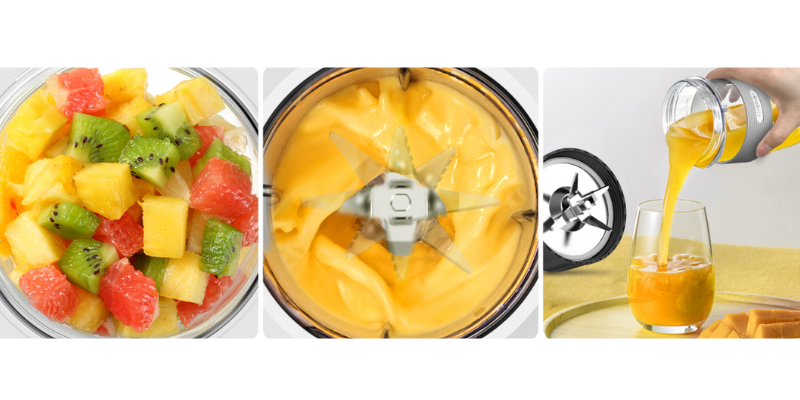Kitchen blenders have become an essential tool for food preparation in modern households. With their ability to chop, puree, and blend various ingredients, they have become a versatile and convenient appliance for any home cook. While many people use blenders regularly, few understand how these machines work. This essay will explore the mechanics behind kitchen blenders and the technology that enables them to perform their tasks efficiently.
What is a Kitchen Blender?
A blender is an electric kitchen appliance that consists of a motorized base and a removable container made of plastic, glass, or stainless steel. The motor powers a set of sharp, rotating blades that chop and blend ingredients into a smooth or chunky consistency, depending on the desired outcome.
How do Kitchen Blenders Work?
The basic operation of a kitchen blender is straightforward. The motor rotates the blades inside the container, which, in turn, grinds and blends the ingredients inside. However, the specifics of how this happens are more complex.

Blades
The blades in a blender are typically made of stainless steel, and they come in various shapes and sizes. The most common shape is a four-pointed star, which is effective at chopping and grinding ingredients. However, other designs, such as the cyclonic blade, can create a vortex that pulls ingredients toward the center of the container, ensuring a more even blend.
The blades are connected to the motor via a coupling mechanism, which transmits the motor's energy to the blades. The coupling can be made of plastic or metal, and it is essential for ensuring that the blades spin correctly.
Motor
The motor in a blender is typically a high-speed electric motor, which can spin the blades at speeds of up to 30,000 revolutions per minute. The power of the motor is measured in watts, and it ranges from 300 to 1500 watts, depending on the blender's size and intended use.
The motor's power determines the blender's ability to blend different ingredients, such as ice or frozen fruit. The more powerful the motor, the more efficiently it can blend tough ingredients.
Container
The container, or jar, in a blender is typically made of plastic, glass, or stainless steel. The container's shape and size can vary, but most blenders have a capacity of 4-8 cups, which is enough for most home cooking tasks.
The container sits on top of the motorized base and contains the blades. Some blenders have a removable blade assembly, which makes cleaning the blades and container more accessible.
Controls
Blenders typically have several control settings that allow users to adjust the speed and duration of the blending process. Most blenders have a low, medium, and high-speed settings, which can be adjusted using a dial or button.
Some blenders also have a pulse setting, which allows users to blend in short bursts. This setting is useful for creating a chunky texture, such as for salsa or guacamole.
Safety Features
Kitchen blenders come with several safety features designed to prevent accidents and injuries. The most common safety feature is a lid that fits tightly over the container and prevents the ingredients from splashing out during the blending process.
Some blenders also have a locking mechanism that prevents the blades from spinning unless the container is securely in place. This feature ensures that users cannot accidentally turn on the blender without the container, preventing injury or damage to the appliance.
Types of Kitchen Blenders
There are several types of kitchen blenders available on the market, each with its unique features and capabilities. The following are some of the most common types of blenders:
Countertop Blenders
Countertop blenders are the most common type of blender and are designed for general use in the kitchen. They are typically larger than other types of blenders and have a capacity of 4-8 cups. Countertop blenders come in various shapes, sizes, and power levels, with some models having more advanced features such as multiple speed settings, pulse mode, and pre-programmed settings for specific recipes.
Personal Blenders
Personal blenders are smaller and more compact than countertop blenders, making them ideal for individuals or small households. They usually have a single-serve container that doubles as a drinking cup, making them perfect for people on the go. Personal blenders are less powerful than countertop blenders, but they are still capable of blending most ingredients.
Immersion Blenders
Immersion blenders, also known as hand blenders or stick blenders, are handheld appliances that consist of a motorized handle and a detachable blending shaft. The shaft is inserted into the container or pot containing the ingredients, allowing users to blend the ingredients directly without transferring them to a separate container. Immersion blenders are ideal for blending soups, sauces, and other liquids.
High-Performance
Blenders High-performance blenders are the most powerful type of blender and are designed for heavy-duty blending tasks. They typically have a motor with a wattage of 1500 or higher, allowing them to blend tough ingredients such as ice, nuts, and frozen fruit with ease. High-performance blenders also have advanced features such as multiple speed settings, pulse mode, and pre-programmed settings for specific recipes.
Blending Process
The blending process in a kitchen blender can vary depending on the type of blender and the ingredients being blended. However, the following is a general overview of the blending process:
Step 1: Prepare Ingredients Before blending, the ingredients must be prepared according to the recipe. This may include washing, peeling, or chopping the ingredients.
Step 2: Add Ingredients to Blender The ingredients are then added to the blender container, taking care not to exceed the maximum capacity of the container.
Step 3: Secure Lid The lid is then secured tightly over the container to prevent any splashing or spillage during the blending process.
Step 4: Choose Speed and Duration The blender's speed and duration settings are then selected according to the recipe's instructions or personal preference.
Step 5: Start Blending The blender is then turned on, and the motor rotates the blades, blending the ingredients together. The duration of the blending process will depend on the desired texture and consistency of the final product.
Step 6: Stop Blending Once the blending is complete, the blender is turned off, and the lid is removed from the container. The blended ingredients can then be poured or scooped out of the container.

Maintenance and Cleaning
Proper maintenance and cleaning of a kitchen blender are essential for ensuring its longevity and performance. The following are some tips for maintaining and cleaning a blender:
Regular Cleaning After each use, the blender container should be rinsed with warm soapy water and then washed thoroughly. The blades and coupling mechanism should also be cleaned carefully to remove any food particles or residue.
Deep Cleaning To deep clean a blender, the container, blades, and coupling mechanism can be disassembled and soaked in warm soapy water. The parts should then be scrubbed with a soft brush to remove any stubborn stains or debris.
Sharpening Blades Over time, the blades in a blender can become dull, which can affect their performance. To sharpen the blades, a food-grade sharpening stone can be used to sharpen each blade's edge.
Lubricating Coupling The coupling mechanism in a blender should be lubricated periodically to ensure that the blades spin correctly. A small amount of food-grade lubricant can be applied to the coupling to prevent it from becoming dry and brittle.
Conclusion
Kitchen blenders are versatile and essential appliances that can make meal preparation more convenient and efficient. By understanding how a blender works and how to maintain and clean it, you can ensure its longevity and optimal performance. Whether you're making a smoothie, pureeing soup, or crushing ice for a cocktail, a blender can quickly and easily blend ingredients together, making it an indispensable tool in any kitchen.

